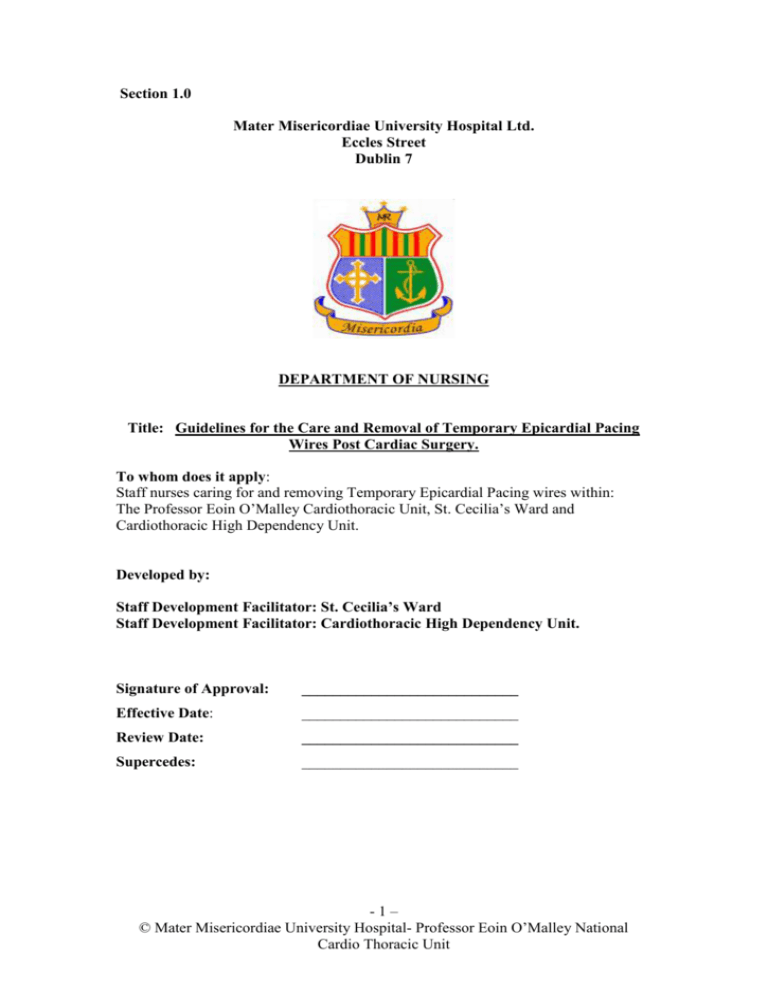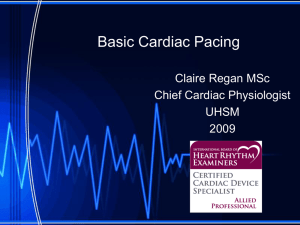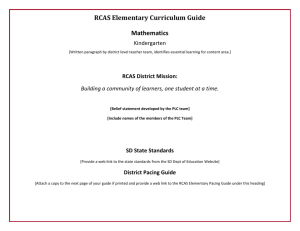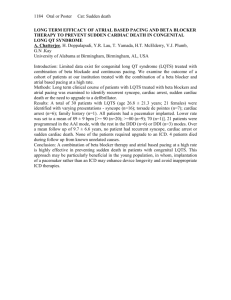Section 10.0: Removal of Temporary Epicardial Pacing Wires
advertisement

Section 1.0 Mater Misericordiae University Hospital Ltd. Eccles Street Dublin 7 DEPARTMENT OF NURSING Title: Guidelines for the Care and Removal of Temporary Epicardial Pacing Wires Post Cardiac Surgery. To whom does it apply: Staff nurses caring for and removing Temporary Epicardial Pacing wires within: The Professor Eoin O’Malley Cardiothoracic Unit, St. Cecilia’s Ward and Cardiothoracic High Dependency Unit. Developed by: Staff Development Facilitator: St. Cecilia’s Ward Staff Development Facilitator: Cardiothoracic High Dependency Unit. Signature of Approval: ____________________________ Effective Date: ____________________________ Review Date: ____________________________ Supercedes: ____________________________ -1– © Mater Misericordiae University Hospital- Professor Eoin O’Malley National Cardio Thoracic Unit Section 2.0 Title: Guidelines for the Care and Removal of Policy/Guideline/Protocol No: Temporary Epicardial Pacing Wires Post Cardiac Surgery. Effective Date: __________________ Appendices: a) Temporary Epicardial Pacemaker Care Approved By: __________________ Plan Written By: Staff Development FacilitatorsCardiothoracic High Dependency Unit and St Cecilia’s Ward Department: Professor Eoin O’Malley Cardiothoracic Unit, St. Cecilia’s Ward and Cardiothoracic High Dependency Unit. Revision: New Review Status: Annual Date Reviewed: __________________ Signature: _______________________ Date Reviewed: __________________ Signature: _______________________ Date Reviewed: __________________ Signature: _______________________ Date Reviewed: __________________ Signature: _______________________ Date Reviewed: __________________ Signature: _______________________ Date Reviewed: __________________ Signature: _______________________ Date Reviewed: __________________ Signature: _______________________ Date Reviewed: __________________ Signature: _______________________ -2– © Mater Misericordiae University Hospital- Professor Eoin O’Malley National Cardio Thoracic Unit Section 3.0: Index Section 1.0 ..................................................................................................................... 1 Title: Guidelines for the Care and Removal of Temporary Epicardial Pacing Wires Post Cardiac Surgery. ...................................................................................... 1 Section 2.0 ..................................................................................................................... 2 Review Status: Annual ............................................................................................ 2 Section 3.0: Index ......................................................................................................... 3 Section 4.0: Terms of Reference: ................................................................................ 4 4.1 Aim of Policy: ............................................................................................... 4 4.2 Clinical areas to which this policy applies: ................................................ 4 4.3 Education and Training: ............................................................................. 4 4.4 This policy must be read in conjunction with the following documents: 4 Section 5.0: Definition of Terms ................................................................................. 5 Section 6.0: Indications for Pacing: ............................................................................ 7 6.1: Temporary Epicardial Pacing in Cardiac Surgical Patients: ...................... 7 6.2: Contraindications: ............................................................................................ 8 6.3: Complications: .................................................................................................. 8 6.4 Most Common Problems Associated with Temporary Epicardial Pacing Wires: ........................................................................................................................ 8 Section 7.0: Types of Temporary Cardiac Pacing: ................................................. 10 7.1: Insertion and Placement Sites: ...................................................................... 10 Section 8.0: NBG Codes and Modes of Pacing ........................................................ 11 8.1 Modes of Cardiac Pacing: ............................................................................... 13 Section 9.0: Care of the Patient with Temporary Epicardial Leads: .................... 14 9.1: Education: ....................................................................................................... 14 9.2: Microshocks: ................................................................................................... 14 9.3: Dressing: .......................................................................................................... 14 Section 10.0: Removal of Temporary Epicardial Pacing Wires: ........................... 15 10.1: Set up trolley with the following equipment: ............................................. 16 10.2 Removing Temporary Epicardial Pacing Wires:........................................ 16 Section 11.0: References ............................................................................................ 20 -3– © Mater Misericordiae University Hospital- Professor Eoin O’Malley National Cardio Thoracic Unit Section 4.0: Terms of Reference: This policy has been developed for Registered General Nurses working within the Eoin O Malley Cardiothoracic Unit incorporating St Cecilia’s Ward and the Cardiothoracic High Dependency Unit, to provide them with a standard of practice to manage patients with Temporary Epicardial Pacing wires. 4.1 Aim of Policy: a. To provide nursing guidelines for the management and care of patients with Temporary Epicardial Pacing Wires. b. To ensure the safety of patients and provide protection for nurses and employing authority. c. To decrease the potential for infection at Temporary Epicardial Pacing Wire sites. 4.2 Clinical areas to which this policy applies: 1. St Cecilia’s Ward 2. Cardiothoracic High Dependency Unit 4.3 4.4 Education and Training: Nursing staff will receive education and training in the management of Temporary Epicardial Pacing Wires to enable them to offer a safe and effective service to the patient. In determining his/ her Scope of Practice, the nurse or midwife must make a judgement as to whether he/she is competent to carry out a particular role/ function. The nurse must take measures to develop and maintain the competence necessary for professional practice (An Bord Altranais, 2000). Registered Nurses must complete the relevant competency in relation to the Management and Removal of Temporary Epicardial Wires. This policy must be read in conjunction with the following documents: 1. Scope of Nursing and Midwifery Practice Framework (An Bord Altranais April, 2000). 2. Recording Clinical Practice Guidance to Nurses and Midwives (An Bord Altranais, 2002). 3. The Code of Professional Conduct for each Nurse and Midwife (An Bord Altranais, April, 2000). 4. Mater Misericordiae University Hospital, Procedures for Staff on the Management and Reporting Incidents (Mater Misericordiae University Hospital, 2006). 5. Mater Misericordiae University Hospital Guidelines and Procedures for the Prevention and Control of Infection in Hospitalised Patients (November, 2005). 6. Guidance to Nurses and Midwives on the Development of Policies, Guidelines and Protocols (An Bord Altranais, December, 2006). -4– © Mater Misericordiae University Hospital- Professor Eoin O’Malley National Cardio Thoracic Unit Section 5.0: Definition of Terms Action Potential: The action potential is brought on by a rapid change in membrane permeability to certain ions, with unique properties necessary for function of the electrical conduction system of the heart. Automaticity: The ability of the cardiac muscles to depolarize spontaneously, i.e without external electrical stimulation from the nervous system. Capture: This is both an electrical and a mechanical event. A pacing spike followed by a corresponding P wave or QRS complex indicates the electrical capture. Cardiac Tamponade: A compression of the heart that occurs when blood or fluid builds up in the space between the myocardium (the muscle of the heart) and the pericardium (the outer covering sac of the heart). Dysrhythmias: Any of a large and heterogeneous group of conditions in which there is abnormal electrical activity in the heart. The heart beat may be too fast or too slow, and may be regular or irregular. Demand Pacing: A pacing stimulus is delivered to the myocardium if the intrinsic rate falls below the set rate on the pacemaker. Epicardial Pacing: Type of temporary pacing where pacing wires are fixed directly to the myocardium (ventricular and often atrial) and are exposed through the skin on the chest wall, usually following cardiac surgery. Epicardium: describes the outer layer of heart tissue. Fixed Rate Pacing: A pacing stimulus is delivered to the myocardium at a programmed fixed rate regardless of the underlying rate and rhythm. This is also known as asynchronous ventricular pacing. Microshocks: Low voltage electrical current from ungrounded equipment or static electricity that may pass through to the patient, with as little as 0.1 mA causing Ventricular Fibrillation. (Beattie, S. 2005) Myocardium: Composed of specialized cardiac muscle cells with an ability to contract, and also carry an action potential (i.e. conduct electricity), like the neurons that constitute nerves. Furthermore, some of the cells have the ability to generate an action potential, known as cardiac muscle automaticity.The blood supply of the myocardium is carried by the coronary arteries. Output: The energy supplied to the heart muscle that is sufficient to stimulate a contraction.. It is determined by three components: Rate: the original setting providing a pacing rate to the myocardium. Amount: level of energy delivered to the pulse generator to the heart to initiate depolarisation and is measured in millamperes. -5– © Mater Misericordiae University Hospital- Professor Eoin O’Malley National Cardio Thoracic Unit Chamber: The atrial, the ventricle or both chambers can be paced. If both the atria and ventricles are paced, a separate output setting is required for each chamber. Pacing: Electronic pacemakers apply small electrical impulses called stimuli to the Atrial mass and/ or the Ventricular mass to trigger these muscle masses to depolarise at the right moments to produce heartbeats at a desired heart rate and sequence. Pacing Wires: Atrial Pacing wires are sutured to the right atrial appendage or the body of the right atrium. Ventricle pacing wires are placed on the anterior or diaphragmatic surface of the right ventricle. Special attention should be paid to the site of lead placement in patients undergoing Coronary Artery Bypass Grafting, with the leads placed behind , rather than in front of the saphenous vein grafts- to avoid the potential complications relating to graft compression and/or injury. Temporary Epicardial Pacing: method of stimulating through the use of Tefloncoated unipolar, stainless steel wires that are inserted loosely to the epicardium after cardiac surgery. The epicardial wires may be attached to the right atrium for atrial pacing, the right ventricle for ventricular pacing or both for atrioventricular (AV) pacing. (Paschal and McErlean, 2000). Temporary epicardial pacing may be especially helpful after Valvular surgery where the incidence of heart block or arrhythmia is increased. Threshold: The minimum energy (output) required to maintain consistent capture. Transvenous Pacing: Type of temporary pacing, where pacing wires are inserted into the veins via an introducer sheath and passed through the venous system to the heart. Transthoracic Pacing: Technique of electrically stimulating the heart by use of a set of pads placed externally on the torso. ECG electrodes are also placed on the patient to sense ventricular events (spontaneous or paced), and the pulse generator delivers a wave pulse when a predetermined escape interval has elapsed. (Boehm, 2007) -6– © Mater Misericordiae University Hospital- Professor Eoin O’Malley National Cardio Thoracic Unit Section 6.0: Indications for Pacing: Table 1: Indications for Pacing Sick Sinus Syndrome Symptomatic Sinus Arrest Suppression of ventricular Ectopy resulting from bradycardia Atrial Fibrillation Bradycardia/tachycardia Syndrome Symptomatic sinus bradycardia Heart Blocks Second degree Type I (occasionally) and Type II Atrioventricular Block Acute Bifasicular or Trifasicular Block Complete Atrioventricular Block Cardiac Arrest with Ventricular Asystole Drug Refractory Dysrhythmia Cardiovascular Surgery Cardiac Transplantation Overdrive ventricular pacing to suppress or prevent ventricular ectopic activity Overdrive pacing to “break” Superventricular Tachycardia or Atrial Flutter Prophylactic use during anaesthesia and surgery in patients with a history of Acute Coronary Syndrome or Cardiac Dysrhythmias Treatment for Complete Heart Block developed during or after surgery Cardiac Output augmentation post operatively The incidence of bradyarrhythmias after Cardiothoracic Transplantation varies between 8-23% (Gregoratos, 2002). In some patients the need for temporary epicardial pacing may be transient 6.1: Temporary Epicardial Pacing in Cardiac Surgical Patients: Epicardial pacing is commonly indicated in cardiac surgical patients using right ventricle (RV) and /or right atrial (RA) pacing wires. In patients with Sinus rhythm, two RV and RA epicardial wires are attached, resulting in dual chamber or sequential atrio-ventricular pacing (DDD) (Flynn, 2005). In terms of temporary pacing post Cardiac Surgery it is known that less than 10% of patients may require the post operative use of Temporary Epicardial Pacing Wires (McClurken, 2006). -7– © Mater Misericordiae University Hospital- Professor Eoin O’Malley National Cardio Thoracic Unit 6.2: Contraindications: Anticoagulation status (Abu-Omar, 2006) Severe lung disease and positive end expiratory pressure ventilation are relative contraindications to Internal Jugular and Subclavian entries. 6.3: Complications: Failure to recognise Ventricular Fibrillation (which is treatable with defibrillation) due to the size of the artifact on the ECG screen. It is important to frequently reassess the patient and the rhythm; defibrillation is indicated immediately if Ventricular Fibrillation occurs. Induction of other dysrhythmias. Follow ACLS guidelines for arrhythmia management. Soft tissue discomfort such as diaphragmatic contractions may result from pacing. Ensure adequate analgesia and sedation. There is potential for local cutaneous injury with prolonged Temporary Pacing. It is important to note that transcutaneous pacing is temporary and it is important to correct the underlying causes for bradydysrrhythmias and/or arrange for transvenous pacemaker placement. Bleeding from Ventricular or Atrial laceration. Bleeding from the wire exit secondary to laceration of the myocardium or nearby blood vessels. Tamponade. Side branch or graft avulsion- where the graft tears away from the attached site. Superior epigastric artery laceration. Transmigration of Temporary Epicardial Pacing Wires. Exit site infection. Infection secondary to retained wire fragments. Injury to saphenous vein grafts. (McClurken, 2006) 6.4 Most Common Problems Associated with Temporary Epicardial Pacing Wires: Table 2: Most frequent causes for pacing failures in cardiac pacing systems. (Feurtes, et al 2003) NO CAPTURE NO OUTPUT Lead dislodgement “Under threshold” programmed output Increase in pacing threshold Breach of insulating material Partial Conductor breach Perforation Circuit failure, air in generator pouch, after defibrillation Battery depletion Lead Fracture Circuit failure Inhibited pacemaker Generator to Lead connection failed Generator screws improperly fixed to the leads Bipolar programming in unipolar leads -8– © Mater Misericordiae University Hospital- Professor Eoin O’Malley National Cardio Thoracic Unit Table 3: Potential problems with Temporary Epicardial Wire Electrodes. (Bojar, 2005) Problem Competition with the patients own rhythm Inadvertent triggering of VT or VF Mediastinal Bleeding Inability to remove the Temporary Epicardial pacing Wires Solution Suspect that the pacemaker is set at a similar rhythm to that of the patients intrinsic mechanism. Discuss with the Cardiothoracic team who may reduce the pacemaker rate or turn off the pacemaker, leaving it attached for observation of the patients rhythm. Can occur through the use of a pacemaker in an asynchronous mode and competes with the patients own mechanism. Pacing wires that are not being used must be electronically isolated to prevent any AC or DC current near the wires, that is, covering with tips with gauze and the wires then covered with Mepore (Beattie, 2005)- See Section 9.2- Microshocks Can occur if the pacing wires are placed close to the Bypass grafts, shearing them by intermittent contact during ventricular contractions. Bleeding from the Atrial and Ventricular surfaces can occur if the wires are sewn too tightly to the heart and excessive traction is applied for their removal. Pacing wires should be removed with the patient off Heparin and before a therapeutic INR is achieved in patients receiving Warfarin. Close observation of the patient should be maintained for several hours post removal of the wires. The wire may be caught beneath a tight suture on the heart, or possibly under a sternal wire or subcutaneous suture. Notify the Cardiothoracic Team immediately, who will assess the wires and may remove or cut them at the level of the skin. -9– © Mater Misericordiae University Hospital- Professor Eoin O’Malley National Cardio Thoracic Unit Section 7.0: Types of Temporary Cardiac Pacing: Percussion: Defined as repeated gentle blows to the middle or lower two thirds of the patients sternum, percussion pacing is used only in emergency settings and is indicated in the following situations Profound Bradycardia resulting in Clinical Cardiac Arrest P-wave asystole (ventricular standstill) (McNaughton 2006) External (Transcutaneous): Electrical stimulation of the excitable myocardial tissue, via adhesive electrodes, which are applied directly to the chest wall. Epicardial: Pacing wires are fixed directly to the myocardium (ventricular and often atrial) and are exposed through the skin on the chest wall. This specific type of pacing is usually observed following cardiac surgery including transplantation. Transvenous: Pacing wires are inserted into the veins via an introducer sheath and passed through the venous system to the heart. Common insertion sites include the Internal Jugular, Subclavian and Femoral Veins. Transthoracic Pacing: Is the technique of electrically stimulating the heart by the use of pads placed externally on the torso. ECG electrodes are also placed on the patient to sense ventricular events (spontaneous or paced), and the pulse generator delivers a wave pulse when a predetermined escape interval has elapsed. The stimulus is intended to cause cardiac depolarisation and subsequent myocardial contraction. (Boehm, 2007) 7.1: Insertion and Placement Sites: Epicardium- post cardiac surgery (coronary artery bypass grafting, valve repair/replacement/cardiac transplantation)- the wires are paired to each chamber and passed through the skin in the Subxiphoid region. Left subclavian Internal jugular Femoral Vein Brachial Vein - 10 – © Mater Misericordiae University Hospital- Professor Eoin O’Malley National Cardio Thoracic Unit Section 8.0: NBG Codes and Modes of Pacing These codes are an international identification code universally referred to as the NBG Code has been produced by the British Pacing and Electrophysiology Group (BPEG) and the North American Society for Pacing and Electrophysiology, (NASPE). Position I: indicates the chamber (or chambers) paced. Position II: represents the chamber used for the second function of a pacemaker, namely, sensing for intrinsic signals. Position III: the mode of response to sensing. Position III is directly tied into position II. Without sensing, there can be no mode of response to sensing. Position IV: Details the programmable parameters of the device. Position V: If the pacemaker device has any anti-tachycardia features. Table 4: Modes of pacing. I II III IV V Chamber Paced Chamber Sensed Response to sensing Programmable Functions/rate Modulation Antitachycardia Functions V: Ventricle V: Ventricle T: Triggered P: Pace A: Atrium A: Atrium I: Inhibited D: Dual (A+V) D: Dual (A+V) D: Dual (T+I) P: Simple programmable M: Multiprogrammable C: Communicating O: None O: None O: None O: None S: Single S: Single R: Rate Modulating O: None S: Shock D: Dual - 11 – © Mater Misericordiae University Hospital- Professor Eoin O’Malley National Cardio Thoracic Unit Table 5: Definition of pacing. 1st Letter 2nd Letter 3rd Letter Chambers paced Chambers sensed Response to Sensing A= Atrium A= Atrium T=Triggered V=Ventricle V= Ventricle I= Inhibit (Demand Mode) D= Dual (both Atrium and Ventricle) D= Dual D=Dual O= none O= none (Asynchrony) Chamber paced Chamber sensed Action or response to a sensed event I V V - 12 – © Mater Misericordiae University Hospital- Professor Eoin O’Malley National Cardio Thoracic Unit 8.1 Modes of Cardiac Pacing: Table 6: Modes of pacing: Mode Chamber Paced Chamber Sensed Response of the Atria and Ventricles None Action or Response to a Sensed Event None AOO Atrium VOO Ventricle None None DOO Dual None None AAI Atrium Atrium Inhibit VVI Ventricle Ventricle Inhibit AAT Atrium Atrium Triggered An asynchronous, fixed rate pacing mode, whereby the ventricles are paced at a preset rhythm. Paces both the atria and the ventricles but they are not sensed. Used when the sinus node is damaged and atrioventricular conduction is unimpaired. Causes the ventricle to be paced, sensed and inhibited. The pacer fires if no QRS is sensed during the preset time interval. Method of pacing both atria simultaneously DVI Dual Ventricle Inhibit VDD Ventricle Dual Dual VAT Ventricle Atrium Triggered DDD Dual Dual Dual The atria are paced but not sensed Dual mode ventricular Inhibited mode of pacing, useful in patients with symptomatic sinus bradycardia or AV Block. Persistence of sinus rhythm with atrial asynchronous ventricular pacing Causes the atria to be sensed but pacing takes place in the ventricles if no P wave is seen. Paces the Atrium and the ventricles, senses the atrium and ventricles and responds to sensed events by inhibiting or triggering. - 13 – © Mater Misericordiae University Hospital- Professor Eoin O’Malley National Cardio Thoracic Unit Section 9.0: Care of the Patient with Temporary Epicardial Leads: 9.1: Education: For the safe management of patients with Temporary Epicardial Leads, nursing care and education is essential to ensure your patients safety and minimise the risk of complications, contributing to a successful outcome. All wires must be kept separate and wires must not overlap. 9.2: Microshocks: While epicardial pacing wires are meant to provide a safeguard against dyssrhythmias, they have the potential to cause a lethal rhythm. Because the unattached wires provide a direct route for electrical current to flow to the heart, any stray current poses a threat to the patient, with as little as 0.1mA causing Ventricular Fibrillation. To avoid Microshocks, when handling pacing wires gloves should always be worn. It is also necessary to keep the wires insulated by covering each one with gauze and sterile, non-adherent, adhesive bordered dressing- Mepore (Beattie, 2005). To avoid stray electrical current, only allow battery operated devices, such as a radio or shaver at the patients bedside. A television with an antenna should be avoided at the patients beside as this can also cause stray electrical current. (Beattie, 2005) Check that all electrical equipment has a grounding pin (third pin). Remove any device that doesn’t have a grounding pin on the plug. If possible carpet should be removed from the room. If this is not possible it may be treated with a product that eliminates static electricity. Discourage family and friends from bringing in metallic-coated “get-well” balloons, as they tend to generate static electricity, therefore posing a risk to patients. 9.3: Dressing: The pacing wire sites can be covered with a sterile, non-adherent, adhesive bordered dressing- Mepore. The sites must be checked daily for signs of infection, such as redness or purulent discharge and a swab sent for Culture and Sensitivity with any change reported to the Cardiothoracic team immediately. The wires must not be bent or pulled during the daily dressing. Accidental dislodgement is another concern with Epicardial wires as they are in a similar position to Chest Drains, which are usually covered with a bulky sternal dressing. It is important to secure the wires directly to the patients chest, covering the tip of the wires with gauze and covering with a sterile nonadherent, adhesive bordered dressing, such as Mepore. (Overbay, 2004). - 14 – © Mater Misericordiae University Hospital- Professor Eoin O’Malley National Cardio Thoracic Unit If the Temporary Epicardial Pacing Wires become frayed or break, notify the Cardiothoracic Team immediately. If the pacing wires are attached to the Pulse generator (Pacing Box) this should be securely hung on an Intravenous Drip stand to prevent it from accidentally dropping to the floor, pulling on the cables or pulling out the wires. Educate the patient, ensuring they understand the importance of not interfering with the wires and the pulse generator (Pacing Box). Ensure that the Pacing box remains in the locked position unless changes in settings are required. 9.4 Battery: The pulse generator (Pacing box) takes its power from batteries (Duracell Procell 9 volt). The battery life is approximately 7 days. It is essential to have a spare battery attached to the pulse generator particularly if the patient has NO underlying rhythm. To identify a reduction in the battery life an L will appear on the screen. Section 10.0: Removal of Temporary Epicardial Pacing Wires: The patient must be hemodynamically stable and the procedure should be completed at least 24 hours prior to the patient being discharged. Epicardial pacing wires are usually removed in accordance with Surgeons preference, aiming for Day 5 postoperative if patient has stable heart rhythms (This is assessed on an individual patient basis daily). NOTE: PATIENTS POST-CARDIAC TRANSPLANTATION AWAIT THEIR FIRST CARDIAC BIOPSY PRIOR TO REMOVAL OF TEMPORARY EPICARDIAL PACING WIRES. Temporary epicardial pacing wires should be removed on instruction from Consultant Cardiothoracic Surgeon or Cardiothoracic Registrar. Continue Cardiac monitoring and assess the patients electrolyte and coagulation status prior to pacing wire removal. Prior to the removal of Temporary Epicardial Pacing Wires, if the patient is on Intravenous Heparin, it should be discontinued temporarily for 4 hours. When the APPT/ACT is normal, the pacing wires can then be removed and Intravenous Heparin commenced 4 hours later. INR must be checked prior to removal of wires if patient is receiving anticoagulant therapy. INR should be < or equal to 2.0 as per all Consultants. If the platelet count is below 150,000 the removal of Temporary pacing wires should be discussed with the Cardiothoracic Team. - 15 – © Mater Misericordiae University Hospital- Professor Eoin O’Malley National Cardio Thoracic Unit 10.1: Set up trolley with the following equipment: Dressing pack. Sterile gloves in pack for performing the dressing. 0.9% Normal Saline sachet – wound cleaning. Stitch cutter – remove tube stitch. Sterile small non-adherent, adhesive border, occlusive dressing, mepore. 10.2 Removing Temporary Epicardial Pacing Wires: 1) 2) 3) 4) Explain the procedure to the patient. Assess patients’ pain score and offer oral analgesia. Attach patient to cardiac monitor. Record baseline vital signs – Blood pressure and heart rate, respirations, oxygen saturations. 5) Remove dressing that is securing the temporary epicardial pacing wires. 6) Wash hands as per MMUH Hand Hygiene and put on gloves provided in dressing pack. 7) Clean puncture site/s with 0.9% NaCL. 8) Remove skin suture if the temporary epicardial pacing wire is sutured in place. 9) Unthread wire until it exits from the skin in one site only. The wires attached to the atrium exit the chest on the right side of the sternum, whilst those attached to the ventricle exit the chest on the left. 10) Gently pull each wire individually, applying steady, slow motion, observing the monitor for dsyrhythmais during procedure. If a lethal arrhythmia develops, stop the procedure and intervene according to Cardiac Arrest management. (Beattie, 2005). 11) If resistance is met during removal, leave the wire insitu and inform the Cardiothoracic team. NOTE: If undue “cardiac tugging” is encountered whilst trying to remove the pacing wire, contact the Cardiothoracic Team. 12) After removal, inspect each wire tip to ensure that it has been removed completely and send tips for Culture and Sensitivity. 13) If bleeding occurs at the site, apply direct pressure until it stops. However, if it continues notify the Cardiothoracic Team. 14) When the procedure is complete, place sterile small non-adherent, adhesive border, and sterile occlusive dressing. 15) Dispose of sharps as per standard precautions. - 16 – © Mater Misericordiae University Hospital- Professor Eoin O’Malley National Cardio Thoracic Unit 16) The patient must rest in bed for one hour following procedure. 17) Record observations at 15-minute intervals for the first hour, then hourly for the next two hours. This is to detect signs of Cardiac Tamponade. (Beattie, 2005) 18) Document date and time of removal of Temporary Epicardial Pacing Wires in nursing care plan. NOTE: Avoid Temporary pacing wire removal after 16.00hrs as per local practice within the Professor Eoin O’Malley Cardiothoracic Unit. For any serious concerns, rapid patient assessment, evaluation and treatment and notification of the Cardiothoracic Team must occur. - 17 – © Mater Misericordiae University Hospital- Professor Eoin O’Malley National Cardio Thoracic Unit Appendix I: Temporary Pacemaker Core Care Plan Patient Name: Date of Temporary Pacemaker insertion: Medical Record Number: Reason for Temporary Pacemaker Insertion: Date Problem Goal(s) Maintaining a safe environment: Patient attached to Temporary Pacemaker 1. Safe management of patients with a Temporary pacemaker No: 2. Minimise the risk of complications. Wound: Pacing Wire Insertion Site 1. There will be no signs of infection at Epicardial pacing wire insertion site. Action/Interventions Continuous cardiac monitoring with monitor alarm on at all times. Check that prescribed pacemaker parameters are maintained and document any changes in parameters by the Cardiothoracic team. Observe the cardiac monitor for appropriate pacemaker function, i.e.: sensing, capturing and pacing. Ensure that the pulse generator (pacing box) is in the locked position at all times unless changes in the settings are required. Ensure that the battery life is regularly checked- a small “L” will appear on the screen when there is reduction in battery life. Ensure that spare batteries are readily available-9 volt Duracell Procell. Ensure pacing wires are secure at all times. Safe guard and Prevention of Microshocks- Pacing wires are covered at all times when not in use with a sterile, non-adherent, adhesive bordered dressingMepore. When handling pacing wires gloves should always be worn. Check all electronic devices have a grounding pin (third pin). To avoid stray current, only battery operated devices, such as a radio or shaver should be kept at the patients bedside. Also Televisions with Antenna should be discouraged from use at the bedside. Discourage visitors from bringing in metallic-coated “get well” balloons, as they can generate static electricity. The pacing wires must be dressed daily as per Local guidelines. The sites must be checked daily for signs of infection, such as redness or purulent discharge and a swab sent for Culture and Sensitivity and report changes to the Cardiothoracic team. Monitor and record the patients temperature 4 hourly and notify the Cardiothoracic team of any changes. - 18 – © Mater Misericordiae University Hospital- Professor Eoin O’Malley National Cardio Thoracic Unit Review care plan each shift Sign Patient Name: Date of Temporary Pacemaker insertion: Medical Record Number: Reason for Temporary Pacemaker Insertion: Date Problem Goal(s) Mobilisation: Restricted mobility due to Temporary Epicardial Pacemaker and leads The patient is able to engage in activities at the bedside whilst understanding the importance of caring for their pacing box and leads. 1.The patient will exhibit a reduction in their level of anxiety. No: Communication: Patient is anxious regarding the temporary Epicardial Pacemaker 2. The patient will demonstrate an awareness of the pulse generator (pacing box). Action/interventions Provide supervision and assistance for the patient as required. Check that the epicardial pacing wires are secure at all times, using a safety pin to secure the pulse generator (pacing box) to the patients pyjamas or hanging safely on an Intravenous pole at the bedside. Encourage full mobility as soon as the patient is able. Educate the patient and encourage active limb exercises whilst mobility is restricted. Educate the patient in awareness of their pulse generator (pacing box) and leads. Provide instruction on the function of the pacemaker. Educate the patient about the importance of performing their activities of daily living whilst the pulse generator (pacing box) is attached. Provide reassurance for the patient and encourage the patient to voice any fears and anxieties in relation to their pulse generator (pacing box) and wires. Provide support, education and encourage questioning for the family in relation to the pulse generator (pacing box), - 19 – © Mater Misericordiae University Hospital- Professor Eoin O’Malley National Cardio Thoracic Unit Review care plan each shift Sign Section 11.0: References Abu-Omar, Y., Guerrieri-Wolf, L. and Taggart, D.P. (2005) Indications and positioning of temporary pacing wires. Multimedia Manual of Cardiothoracic surgery. Akowuah, E.F., Rajnish, R., Tomkins, S. and Hutter, J. (2008) pseudo cardiac tamponade: a rare complication of temporary epicardial wires. European Journal of Cardiothoracic Surgery. 33, 738. Amoore, J. and Ingram, P (2003) Learning from adverse events involving medical devices. Nursing Standard. 17 (29), 41-46. Beattie, S. (2005) Epicardial wires. RN Web. 1-3. Boehm, J (2007) Tried and True: non-invasive transthoracic pacing. Code Communications. II (6). Bojar, R.M (2005) Manual of perioperative care in adult cardiac surgery (4th edition), Blackwell Publishing, USA. Carroll KC, Reves L.M et al., (1998) Risks associated with removal of ventricular epicardial pacing wires after cardiac surgery. American Journal of Cardiac Critical Care. 7 (6), 449. Cęliker, A., Ceviz, N. and Küċükosmanoğlu, O. (2005) Long term results of endocardial pacing with Autocapture threshold tracking pacemakers in children. Eurospace. 7, 569-575. Collins, K.K., Thiagarajan, R.R., Clifford, C., Dubin, A.M., Van Hare, G.F., Mayer, J.E., Bernstein, D., Robbins, R.C., Berul, C.I., and Blume, E. (2003) Atrial Tachyarrhymias and permanent pacing after paediatric heart transplantation. Journal of Heart and Lung Transplantation. 22(10), 1126-1133. Eltrafi, A., Currie, P. and Hilas, J.H. (2000) Permanent pacemaker insertion in a district general hospital: indications, patient characteristics and complications. Postgraduate Medical Journal. 76, 337-339. Enrol, M.K. Sevimli, S. and Ates, A. (2005) Pericardial tamponade caused by transvenous temporary endocardial pacing. Heart. 91, 459. Finkelmeier B. A., (2000) Cardiothoracic Surgical Nursing. 2nd Edition Lippincott, Philadelphia U.S.A. Flynn, M.J., McComb, J. and Dark, J.H (2005) Temporary left ventricle pacing improves hemodynamic performance in patients requiring epicardial pacing post cardiac surgery. European Journal of Cardiothoracic Surgery. 28, 250-253. Fox, D.J., Fitzpatrick, A.P., and Davidson, N.C. (2005) Optimisation of cardiac resynchronisation therapy: addressing the problem of “non-responders”. Heart. 91, 1000-1002. - 20 – © Mater Misericordiae University Hospital- Professor Eoin O’Malley National Cardio Thoracic Unit Fuertes, B., Toquero, J., Arroyo-Espliguero, R., Lozano, I.F. (2003) Pacemaker Lead Displacement: mechanisms and management. Indian Pacing and Electrophysiology Journal. 3(4), 231-238. Gammage, M. (2000) Electrophysiology: temporary cardiac pacing. Heart. 83, 715720. Gibson, T. (2008) A practical guide to external cardiac pacing. Nursing Standard. 22, 20, 45-48. Jahangir, A., Shen, W-K., Neubauer, S.A., Ballard, D.J., Hammill, S.C., Hodge, D.O., Lohse, C.M., Gersh, B.J. and Hayes, D.L. (1999) Relation between mode of pacing and long term survival in the very elderly. Journal of the American College of Cardiology. 33 (5), 1208-1216. Johnson LG, Brown OF, Alligood MR., (1993) Complications of epicardial pacing wire removal. Journal of Cardiovascular Nursing. 7(2), 32 – 40. Kusumoto, F.M. and Goldschlager, N. (2006) Implantable Cardiac arrhythmia devices- part 1: pacemakers. Clinical Cardiology. 29, 189-194. MacCarthy, P.A. (2002) Practical procedures in cardiology. Medicine. 202-207. Manion PA. (1993) Temporary pacing in the postoperative cardiac surgical patient. Critical Care Nurse.13 (2), 30 – 38. McCann, P. (2006) A review of temporary cardiac pacing wires. Indian Pacing and Electrophysiology Journal. 7(1), 40-49. McClurken, J.B (2006) Minimizing complications from temporary Epicardial pacing Wires after Cardiac Surgery. Pennsylvania Patient Safety Authority. McHale, L., D.J., Rigs, K.L.and Thuruman L., (1991) Epicardial pacing after cardiac surgery. Critical Care Nurse. 11(8), 62 –74. Murphy, J.J. (2001) Problems with temporary cardiac pacing- Editorial. British Medical Journal. 323: 527. Overbay, D. and Criddle, L. (2004) Mastering temporary invasive cardiac pacing. Critical Care Nurse. 24(3). Özin, B., Sezgin, A., Atar, I., Gülmez, O., Saritas, B., Gültekin, B., Kormaz, M.E., Yildirir, A., Aşlamaci, S., and Müderrisoğlu.(2005) Effectiveness of Triple-Site triggered atrial site for prevention of atrial fibrillation after coronary artery bypass grafting. Clinical Cardiology. 28,479-482 Petch, M.C. (1999) Temporary cardiac pacing. Postgraduate Medical Journal. 75, 577-578. - 21 – © Mater Misericordiae University Hospital- Professor Eoin O’Malley National Cardio Thoracic Unit Puskas, J.D. et al (2003) Is routine use of temporary epicardial pacing wires necessary after either OPCAB or conventional CABG/CPB. The Heart Surgery Forum. 6(6) E103-E106. Robinson C.F. (2001) AACN Procedure Manual for Critical Care. W. B Saunders Company, Pennsylvania, U.S.A. Silver, M.D. and Goldschlager, N. (1988) Temporary transvenous cardiac pacing in the critical care setting. Chest. 93, 607-613. Sierra, J. and Rubio, J. (2008) Transvenous right ventricular pacing in a patient with tricuspid mechanical prosthesis. Journal of Cardiothoracic Surgery. 3(42). Sponitz, H.M. (2005) Optimizinig temporary perioperative cardiac pacing. Journal of Thoracic and Cardiovascular Surgery. 129, 5-8. Trohman, R.G., Kim, M.H. and Pinski, S.L. (2004) Cardiac pacing: state of the art. Lancet. 364, 1701-1719. Wood, M.A. and Ellenbogen. K.A. (2002) Cardiac pacemakers from a patients perspective. Circulation. 105, 2136-2138. - 22 – © Mater Misericordiae University Hospital- Professor Eoin O’Malley National Cardio Thoracic Unit








